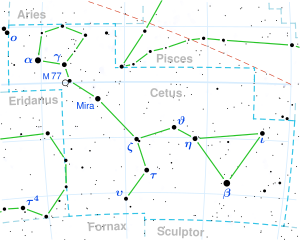格利泽1005
格利泽1005是一個位於鯨魚座兩顆紅矮星組成的恆星系統,距離地球19.6光年。[7]主星是M4V級星,而伴星是M7V級星。
| 觀測資料 曆元 J2000 | |
|---|---|
| 星座 | 鯨魚座 |
| 星官 | |
| 赤經 | 00h 15m 28.11090s[1] |
| 赤緯 | -16° 08′ 01.6303″[1] |
| 視星等(V) | 11.483[2] |
| 特性 | |
| 光谱分类 | M3.5V[3] |
| 天体测定 | |
| 徑向速度 (Rv) | -26.43 ± 0.1[4] km/s |
| 自行 (μ) | 赤经:731.83[1] mas/yr 赤纬:-607.73[1] mas/yr |
| 视差 (π) | 166.6 ± 0.3[3] mas |
| 距离 | 19.58 ± 0.04 ly (6.00 ± 0.01 pc) |
| 绝对星等 (MV) | 12.70 ± 0.01 / 15.12 ± 0.09[3] |
| 軌道[3] | |
| 繞行週期 (P) | 4.55726+0.00075 −0.00074 y.[5] |
| 半長軸 (a) | 0.3037 ± 0.0005" |
| 偏心率 (e) | 0.36136+0.00097 −0.00098[5] |
| 倾斜角 (i) | 143.93+0.25 −0.24[5]° |
| 升交点黃經 (Ω) | 62.8 ± 0.4° |
| 近心点 曆元 (T) | JD 2449850.4 ± 0.8 |
| 近心點幅角 (ω) (secondary) | 166.6 ± 0.5° |
| 詳細資料 [3] | |
| GJ 1005 A | |
| 質量 | 0.179 ± 0.002 M☉ |
| 溫度 | 3341+224 −[6] K |
| 金属量 [Fe/H] | -0.41[5] dex |
| GJ 1005 B | |
| 質量 | 0.112 ± 0.001 M☉ |
| 其他命名 | |
| 參考資料庫 | |
| SIMBAD | 资料 |
| ARICNS | A |
| B | |
格利泽1005在鯨魚座的位置 | |
參考
编辑- ^ 1.0 1.1 1.2 1.3 van Leeuwen, F.; et al. Validation of the new Hipparcos reduction. Astronomy and Astrophysics. 2007, 474 (2): 653–664 [2023-03-21]. Bibcode:2007A&A...474..653V. S2CID 18759600. arXiv:0708.1752 . doi:10.1051/0004-6361:20078357. (原始内容存档于2019-12-07).
- ^ Koen, C.; Kilkenny, D.; van Wyk, F.; Marang, F. UBV(RI)C JHK observations of Hipparcos-selected nearby stars. Monthly Notices of the Royal Astronomical Society. 2010, 403 (4): 1949–1968. Bibcode:2010MNRAS.403.1949K. doi:10.1111/j.1365-2966.2009.16182.x .
- ^ 3.0 3.1 3.2 3.3 3.4 Benedict, G. F.; Henry, T. J.; Franz, O. G.; McArthur, B. E.; Wasserman, L. H.; Jao, Wei-Chun; Cargile, P. A.; Dieterich, S. B.; Bradley, A. J.; Nelan, E. P.; Whipple, A. L. The Solar Neighborhood. XXXVII. The Mass–Luminosity Relation for Main-Sequence M Dwarfs. The Astronomical Journal. 2016, 152 (5): 141. Bibcode:2016AJ....152..141B. S2CID 54029447. arXiv:1608.04775 . doi:10.3847/0004-6256/152/5/141.
- ^ Nidever, David L.; et al. Radial Velocities for 889 Late-Type Stars. The Astrophysical Journal Supplement Series. 2013, 141 (2): 503–522. Bibcode:2002ApJS..141..503N. S2CID 51814894. arXiv:astro-ph/0112477 . doi:10.1086/340570.
- ^ 5.0 5.1 5.2 5.3 Mann, Andrew W.; Dupuy, Trent; Kraus, Adam L.; Gaidos, Eric; Ansdell, Megan; Ireland, Michael; Rizzuto, Aaron C.; Hung, Chao-Ling; Dittmann, Jason; Factor, Samuel; Feiden, Gregory; Martinez, Raquel A.; Ruíz-Rodríguez, Dary; Chia Thao, Pa, How to Constrain Your M Dwarf. II. The Mass–Luminosity–Metallicity Relation from 0.075 to 0.70 Solar Masses, The Astrophysical Journal, 2019, 871 (1): 63, Bibcode:2019ApJ...871...63M, S2CID 119372932, arXiv:1811.06938 , doi:10.3847/1538-4357/aaf3bc
- ^ Costa-Almeida, Ellen; De Mello, Gustavo F Porto; Giribaldi, Riano E.; Lorenzo-Oliveira, Diego; Ubaldo-Melo, Maria L., M dwarf spectral indices at moderate resolution: Accurate Teff and [Fe/H] for 178 southern stars, Monthly Notices of the Royal Astronomical Society, 2021, 508 (4): 5148–5162, arXiv:2110.01658 , doi:10.1093/mnras/stab2831
- ^ 7.0 7.1 Hershey, John L.; Taff, L. G. Hubble Space Telescope Fine Guidance Sensor Astrometry of the Low-Mass Binary L722-22. The Astronomical Journal. 1998-01-01, 116 (3): 1440. Bibcode:1998AJ....116.1440H. ISSN 1538-3881. doi:10.1086/300516 (英语).
